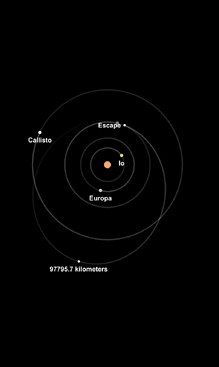Some or all of the features on this page requires the Planets Expansion in-app purchase.
Ganymede is the largest and second-most distant of Jupiter’s Galilean moons. It is larger than Mercury and is grey-brown in color with white streaks. This color is due to ice on its surface. It is included in the Planets Expansion DLC.
Landing on Ganymede is hard, harder than in Io, because of the large gravity and rough terrain. Ganymede has the second-largest gravity of all Galilean moons at 1.43 m/s2
What to do on Ganymede[]
Ganymede’s high gravity makes it a prime target for gravity assists. Very low passes can be made due to the uneven terrain not stretching much higher than 100 meters.

Ganymede gravitational slingshots can be useful. Here a rocket got a higher apojove from a Ganymede gravity slingshot.
As seen in the picture to the left, a Ganymede encounter can be useful because of its large gravity. Ganymede's gravity can be used to get to another moon or lower or higher Jupiter orbit easily (with the right timing and position).
Like Io, orbital insertion can be quite expensive.
Terrain[]
Ganymede’s surface is perhaps the most interesting out of all of Spaceflight Simulator’s planets and moons. The surface is mostly filled with many small hills and many irregularities in these hills. Ganymede's hills can be up to 90 meters in height. The hills may be small, but they are steep. In some places, the surface is relatively flat with a few tiny irregularities emerging out from the ground. If the landing footprint is in rough terrain, you may land on a spot that will cause your rocket to tip. However, the rough regions double as prime driving locations for moderately-sized rovers.
Gallery[]
Trivia[]
- Ganymede is so large that it's larger than Titan (Saturn's biggest moon) and 41.3% the size of Earth.
- Ganymede could be considered a planet if it wasn't orbiting Jupiter.
- Ganymede has a magnetic field and even faint auroras.
- Like the rest of the Galilean moons, Ganymede was a lover of Zeus, who abducted him to become a cup-bearer for the Olympians.
- Ganymede formed in Jupiter’s nebula in about 10,000 years.
- The high radiation on Ganymede would kill a person in 2 months.
- Ganymede is the largest of all moons in-game and in real life in the solar system, larger than Mercury.
- Ganymede has an atmosphere that is mainly composed of oxygen.
- Ganymede has polar caps, just like Earth and Mars. They are made out of frost and extend until 40° latitude.
| Free | Planet DLC required | Upcoming/Custom | ||
| Sun • Mercury • Venus • Earth • Mars | Jupiter | Saturn • Uranus • Neptune | ||
| Mercury | ||||
| Venus | ||||
| Earth • Moon (Luna) • Captured Asteroid | ||||
| Mars • Deimos • Phobos | ||||
| ⠀ |
Jupiter • Io • Europa • Ganymede • Callisto | Metis • Thebe • Amalthea • Adrastea | ||
| Saturn • Mimas • Enceladus • Tethys • Dione • Rhea • Titan • Iapetus • Hyperion | ||||
| Uranus • Miranda • Ariel • Umbriel • Titania • Oberon | ||||
| Neptune • Triton • Proteus • Nereid • Larissa • Galatea | ||||
| Ceres • Pluto (Charon • Nix • Hydra • Stix • Kerberos) • Haumea (Hi'iaka • Namaka) • Makemake (MK2) • Eris (Dysnomia) • Sedna | ||||


